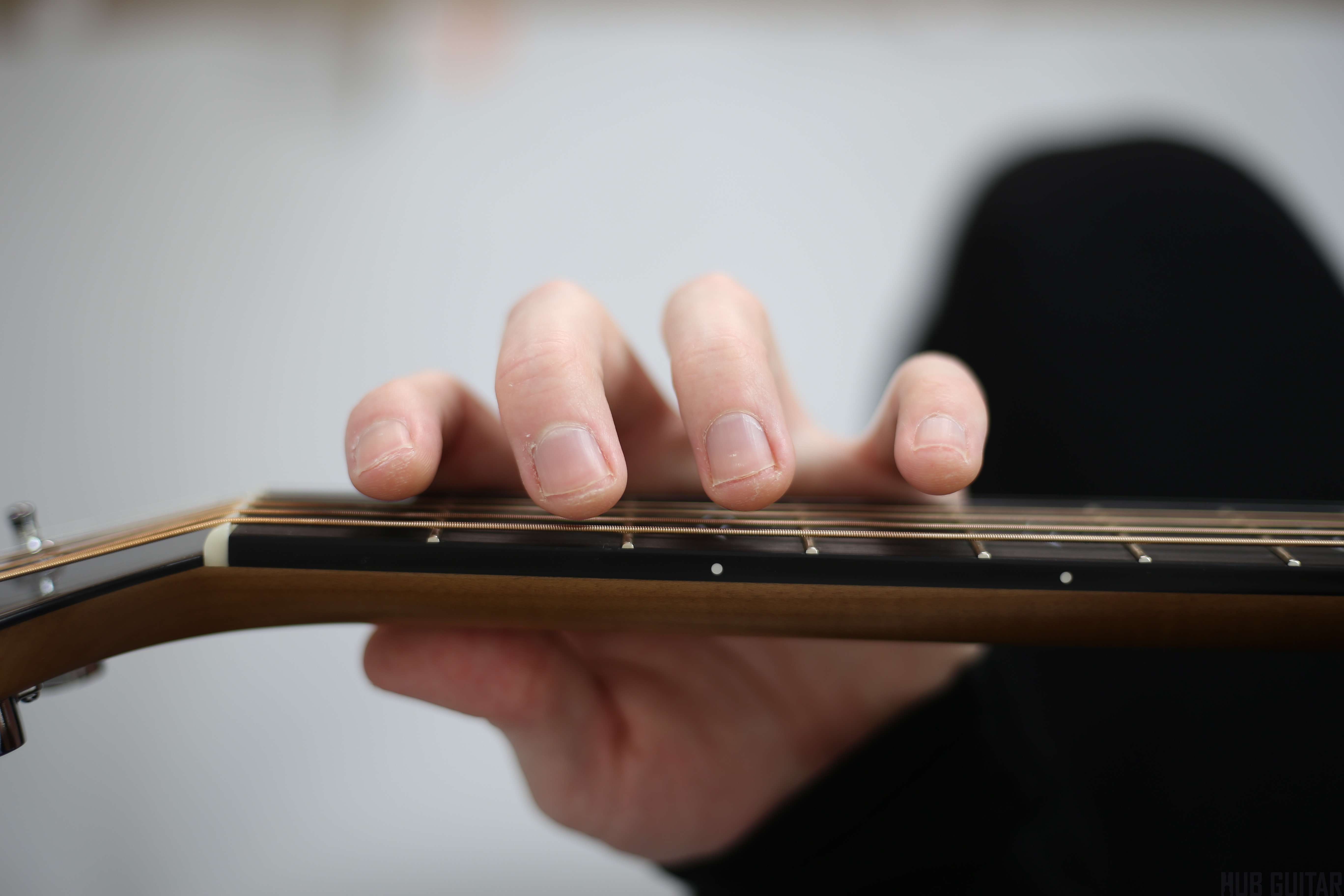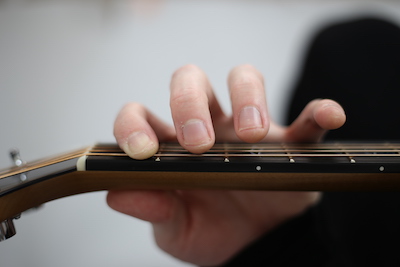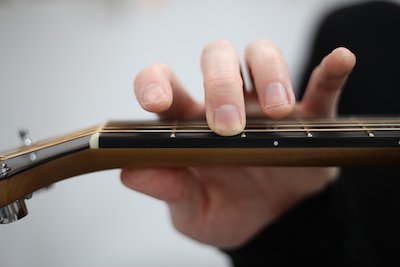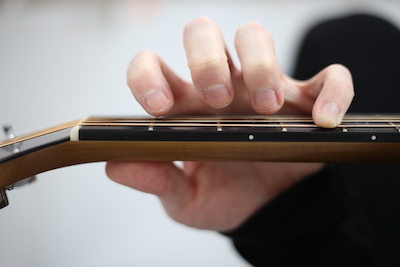Introduction to Fingers Used

The four fingers of the fret hand
The Fretting Hand
The fingers on the fretting hand play a constant role regardless of the style of guitar playing. For most players, the fretting hand will be the left hand—that’s the hand that pushes down on the frets to make notes. However, if you play a left-handed guitar, this is opposite; you will push down on the notes with your right hand. (In guitar, the hand that plucks the strings is considered the dominant one.)
Before attempting to learn the guitar, you must cut the fingernails of the fretting (the left hand for most right-handed people) hand. They must be cut as short as possible. There is no getting around it. You simply can’t play the guitar with fingernails on the fretting hand. It is impossible.
Fret-Hand Thumb
The fret-hand thumb is responsible for securing and supporting the rest of the hand by being placed behind the guitar neck and helping “push” the guitar neck back towards the direction of the fingers that are on the opposite side fretting notes.
Fret-Hand Index Finger
The fret-hand index finger plays an important role in establishing the position. If the index finger is lined up to Fret V, that is what determines that the hand is in “position V”. So the position is just which fret the index finger is on, for the most part. The exception is that this finger can also stretch one fret lower than the current position. In the case of Position V, it could stretch to fret IV, but the middle finger would still be on Fret VI.
The index finger is often called upon to play barre chords, by laying across all of the strings of a single fret, and fretting them all at once. This is an advanced technique best avoided by beginners—for now.
Finally, due to its position as the first in the row, the index finger will be responsible for position shifts going downwards. That means that if you’re playing in Position V, and need to move down to Position III, the index finger would normally lead the way.
Fret-Hand Middle and Ring Fingers
These fingers have a similar role. Within any given position, they will tend to have an “assigned place” that they don’t move from.
Fret-Hand Pinky
The pinky of this hand is very important because it is often weak, and sometimes cannot pull its own weight. For this reason, it’s very important to practice using the pinky for scales and chords.
In addition, the pinky’s position at the end of the row of four fingers means that it will sometimes be called upon to stretch. In Position V, where the index finger lines up with Fret V, the pinky will line up with Fret VIII. But any notes required in Fret IX will also be played by the pinky, which will stretch to reach them.
The pinky presents a contradiction! On the one hand, it is weak and there are times when it is best to avoid using it. On the other hand, it is wise to develop the pinky so it can be used when called upon.
The Picking Hand
The role of the fretting hand fingers in playing the guitar depends on if you’ll be playing pick stylePick style refers to methods of playing the guitar that use a pick or plectrum, a small tab of plastic or other material used to strike strings. This is in contrast with fingerstyle, where strings are attacked with the fingers. or fingerstyleSometimes used to refer to a particular technique of playing with the fingers, but also often used as a general term for playing the guitar strings with the picking-hand fingers. or even hybrid styleA style of guitar playing which uses the pick, normally held by the thumb and index finger of the picking hand, and any or all of the remaining fingers on that hand. A blend of pick style and fingerstyle..
Pick style
In pick style guitar, the pick is normally held with the thumb and index finger of the picking hand. The rest of the fingers are normally not used.
Advantages: this style can be very straightforward for beginners to learn. It’s also very common. It’s great for strumming chords or playing lead.
Disadvantages: this style cannot create as many different textures as fingerstyle, and playing solo arrangements with bass, chords and harmony can be ruled out.
Fingerstyle
In fingerstyle guitar, the thumb, index finger, middle finger, and ring finger are normally used. They are given the abbreviations: “p, i, m, a” which come from the Spanish words for those fingers. They are used together in many different combinations and sequences. The pinky is often not used in fingerstyle, although it can be.
Advantages: this style is excellent for playing solo arrangements or nicely-textured guitar accompaniments.
Disadvantages: particularly for steel string guitar, it is not easy to play lead lines with this style.
Hybrid style
In hybrid style guitar, two fingers hold the pick (usually the thumb and first finger) and the remaining fingers can be used as in finger style guitar. The pinky is often used as well, since otherwise there would only be two extra fingers available.
Advantages: this style combines some of the advantages of pick and fingerstyle.
Disadvantages: some players feel that it is difficult to blend the sound of pick and fingers as the notes played by the pick sometimes sound louder. In addition, it can be difficult to train the fingers to react independently of the pick, and it can be difficult to make effective use of the pinky.
Other styles
There are many other approaches to plucking the guitar strings. Some players wear plastic picks that can be slipped over the fingers. Another notable approach (used by Doyle Dykes and the like) is to use a plastic pick worn on the thumb and play fingerstyle with the remaining fingers.
 As the creator of Hub Guitar, Grey has compiled hundreds of guitar lessons, written several books, and filmed hundreds of video lessons. He teaches private lessons in his Boston studio, as well as via video chat through TakeLessons.
As the creator of Hub Guitar, Grey has compiled hundreds of guitar lessons, written several books, and filmed hundreds of video lessons. He teaches private lessons in his Boston studio, as well as via video chat through TakeLessons.

